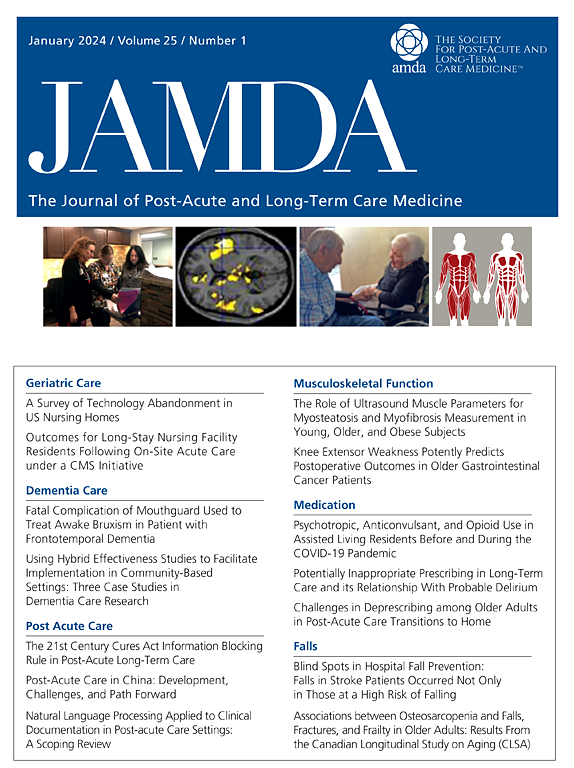Performance Indicators for the Assessment of Aging-In-Place Reform Policies: A Scoping Review and Evidence Map
IF 4.2
2区 医学
Q2 GERIATRICS & GERONTOLOGY
Journal of the American Medical Directors Association
Pub Date : 2024-09-05
DOI:10.1016/j.jamda.2024.105249
引用次数: 0
Abstract
Objectives
Many countries have reformed their long-term care system to promote aging-in-place. Currently, there is no framework for evaluating these reforms. This review aimed to identify performance indicators used for aging-in-place reform evaluation.
Design
A scoping review and evidence map of literature following the Preferred Reporting Items for Systematic Reviews and Meta-Analyses Extension for Scoping Reviews checklist.
Setting and participants
Long-term care reforms aimed at aging-in-place.
Methods
The databases Medline, Embase, and Academic Search Premier were searched. Three independent reviewers screened the articles. Pairs of data collectors extracted the data, with conflicts determined by agreement or by a third reviewer. Performance indicators were classified into the Donabedian framework as structure, process, or outcome.
Results
We retained 58 articles. From the included articles, 28 discussed structure indicators, comprising of 71 indicators in the domains expenditures, care availability, and workforce; 36 articles included process indicators comprising 80 indicators about care utilization, service quality, and service satisfaction; and 20 articles reported on outcome indicators comprising 34 indicators about health status and informal caregiving.
Conclusion and Implications
Most articles focused on the performance domains care expenditures and care utilization, whereas measuring effects on older adults and society was less common. A framework assessing system and services delivery indicators and the effects on those aging-in-place with actionable performance indicators is recommended.
评估就地养老改革政策的绩效指标:范围审查和证据图。
目标:许多国家对其长期护理系统进行了改革,以促进就地养老。目前,还没有评估这些改革的框架。本综述旨在确定用于就地养老改革评估的绩效指标:设计:按照《系统性综述和元分析扩展首选报告项目》的范围界定综述核对表,对文献进行范围界定综述和证据地图绘制:环境和参与者:旨在实现就地养老的长期护理改革:检索了 Medline、Embase 和 Academic Search Premier 等数据库。三位独立审稿人对文章进行了筛选。两对数据收集者提取数据,冲突由双方同意或第三位审稿人决定。绩效指标按照多纳比德框架分为结构、过程或结果:我们保留了 58 篇文章。在纳入的文章中,28 篇讨论了结构指标,包括支出、护理可用性和劳动力领域的 71 个指标;36 篇文章纳入了过程指标,包括护理利用、服务质量和服务满意度方面的 80 个指标;20 篇文章报告了结果指标,包括健康状况和非正式护理方面的 34 个指标:大多数文章侧重于护理支出和护理利用的绩效领域,而衡量对老年人和社会的影响的文章较少。建议制定一个框架,评估系统和服务提供指标以及对就地养老者的影响,并制定可操作的绩效指标。
本文章由计算机程序翻译,如有差异,请以英文原文为准。
求助全文
约1分钟内获得全文
求助全文
来源期刊
CiteScore
11.10
自引率
6.60%
发文量
472
审稿时长
44 days
期刊介绍:
JAMDA, the official journal of AMDA - The Society for Post-Acute and Long-Term Care Medicine, is a leading peer-reviewed publication that offers practical information and research geared towards healthcare professionals in the post-acute and long-term care fields. It is also a valuable resource for policy-makers, organizational leaders, educators, and advocates.
The journal provides essential information for various healthcare professionals such as medical directors, attending physicians, nurses, consultant pharmacists, geriatric psychiatrists, nurse practitioners, physician assistants, physical and occupational therapists, social workers, and others involved in providing, overseeing, and promoting quality

 求助内容:
求助内容: 应助结果提醒方式:
应助结果提醒方式:


